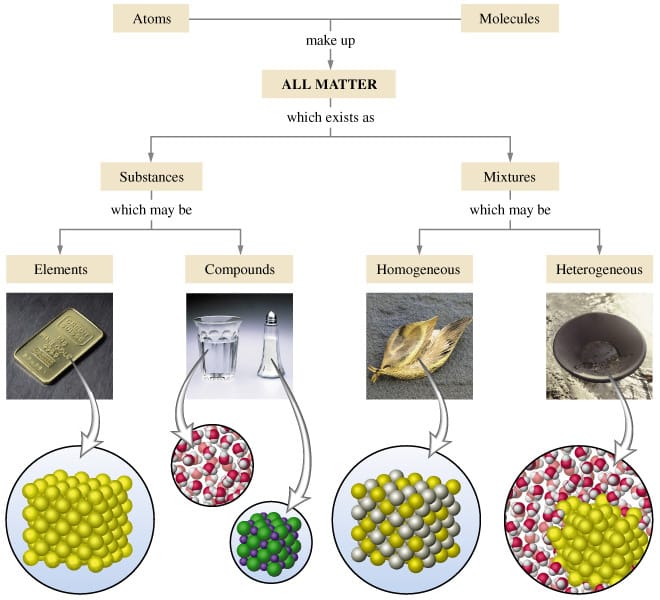A way to classify matter is to divide it into synthetic and natural materials. Natural materials are those found in nature. For example: wood, cotton (cotton grows on plants), rocks, wool, eggs, and even human beings. These materials are not made in a factory or a laboratory. Synthetic materials are those that are man-made. They are made in factories or laboratories. For example: steel, polyester, nylon, plastics, and rubber. None of these materials are found in nature. All matter, however, whether it is natural or synthetic is made up of atoms and can be classified in a system we’ve discussed before…
PURE SUBSTANCES
A pure substance is a piece of matter that only contains one type of particle, or building block. Elements are pure substances that only contain one type of atom. For example: diamonds only contain carbon atoms, and a strip of magnesium metal only contains magnesium atoms. Each element contains its own specific atom. Some elements exist in nature as diatomic (literally: made of 2 atoms) molecules. For example, the oxygen you breathe exists as a diatomic molecule: O2. This means it is 2 atoms of oxygen connected (or bonded) together. Other diatomic elements include nitrogen (N2), chlorine (Cl2) and fluorine (F2). Compounds are pure substances that consist of two or more atoms bonded together. Compounds do not include diatomic molecules; they only include substances made up of two or more different elements. Compounds always exist in specific rations. Two atoms of hydrogen and one atom of oxygen together (H2O) will always be water. Two atoms of hydrogen and TWO atoms of oxygen together (H2O2) is not water, it is hydrogen peroxide (a disinfectant). Other examples of compounds include carbon dioxide (CO2), glucose (sugar) (C6H12O6), calcium carbonate (chalk) (CaCO3), and all the compounds used in fireworks. Atoms can combine in so many ways that there is almost an endless amount of different compounds.
MIXTURES
A mixture is a substance made out of two or more pure substances. Most natural and synthetic substances are mixtures. For example: Steel is a mixture of iron and carbon, and rocks are a mixture of various metal elements such as nickel, iron, and copper. Mixtures exist in all three phases of matter (solid, liquid, and gas). Some mixtures have molecules in all three states. For example, a can of Pepsi will have solid sugar molecules, liquid water molecules, and carbon dioxide gas molecules.
HETEROGENEOUS AND HOMOGENEOUS MIXTURES
The prefixes (prefixes are small words that go in front of other words) “hetero” and “homo” have specific meanings. “Hetero” means “different” and “homo” means “same.”
Heterogeneous mixtures
- This is a mixture where the different pure substances in the mixture are clearly visible and change at every part throughout the substance.
- For example, Lucky Charms cereal is an example of a heterogeneous mixture. You can easily see that it is made out of different oat shapes and different marshmallows. Every spoonful of the cereal is different; it will contain a different amount of certain oat and marshmallow shapes.
- What are some other examples of heterogeneous mixtures?
Homogeneous Mixtures
- In these mixtures, the pure substances mix together so well that the mixtures looks the same throughout and could be mistaken for one substance instead of a mixture.
- For example, milk is a homogeneous mixture. As we discussed yesterday, milk is made up of many different ingredients. All the ingredients, however, mix together so well that you cannot tell it is a mixture. Every drop of milk looks the same.
- What are some other examples of homogeneous mixtures?
Now that we’ve been able to classify matter into different categories, let’s organize all this data in a diagram:

